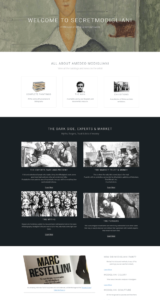by Daniel J. Voelker, forensic historian and art lawyer
While fraud and forgery in the art world are not new phenomena, the works of Modigliani may be setting a new bar for a confluence of value-enhancing factors, including scarcity and an inventory of outed fakes that have driven prices to record highs. The caveat on the frenetic market for authentic Modigliani art is the challenge of finding one in the first place.
Because the artist’s work is infamous for numerous cases of forgery within the highest circles of the art world, coupled with poor documentation, there were previously believed to be only 337 authentic Modigliani works in existence (Esterow, 2017).
But this is about to change. Several parties have been quietly working on new catalogues and new validating technologies to shake up the global Modigliani collecting market, which may result in a king’s ransom of works being authenticated and brought to market.
The realization that so many extant fakes reside on the walls of collectors, accompanied by equally worthless certificates of provenance, has led to the drive for new, validated catalogues of work. For those who can prove provenance the payoff is on par with any other scarce collectible. Paintings purchased prior to 1950 for less than $5,000 are now insured and estimated to be worth $20,000,000 or more. In just the past five years, Modigliani’s 1917 painting “Nu Couche,” sold at auction for 170.4 million dollars (CNBC, 2018).
Countless stories of false authenticity hang like a black cloud over the Modigliani market, creating enough uncertainty and skepticism to make the sale of any work a challenge. The paucity of agreed-upon catalogues creates a double-edged conundrum: the seller can’t guarantee authenticity and the buyer can’t validate a purchase. Modigliani imposters are so pervasive that it’s become something of a joke in the industry. “Modigliani was producing more dead than when he was alive,” remarked Carlo Pepi, a well-known Italian art collector (Cohen, 2014).
Authentication is the bane of Modigliani’s pedigree
The challenge of authenticating the artist’s works literally began within decades of his demise. Amedeo Clemente Modigliani (1885-1920) led a sketchy, Bohemian existence in Paris fueled by absinthe and hashish that propelled him deeply into strange, anti-social behavior. Read our Modigliani biography here…
Claims of authenticity have for years proven to be worthless, as have whole exhibitions of the artist’s work. In 2018, Modigliani expert Isabella Quattrocchi determined a third of the works at a Modigliani exhibition in Genoa were fakes. Twenty-one paintings and sketches attributed to Modigliani and his contemporary, Moise Kisling, had been “crudely forged,” and the entire exhibition was shuttered. Its curator, Rudy Chiappini, laid the blame on the painting’s owners and each piece’s associated provenance (D’Emilio, 2018). In 2012 famed art expert Christian Gregori Partisot, who had himself issued many certificates of authenticity, was arrested by Italian authorities, charged with selling forged Modiglianis, and later convicted.
The quest to catalogue
Ambrogio Ceroni wrote the first and most reliable catalogue of Modiglianis in 1958, with the last update in 1970. But, Ceroni never examined or catalogued any of Modigliani’s works that had been relocated outside of Europe past late 1940’s. Due to the popularity of Modigliani’s works in the 1920s, 30s and 40s, many had been sold and had made their way to the United States, Canada and elsewhere. Ceroni recognized this ambiguity in his catalogue and claimed it was not intended to be exhaustive.
Many of the Modiglianis that did not appear in the Ceroni catalogue have since been authenticated at Restellini’s laboratory in Paris and certificates of authenticity have been issued. Hopefully this validation effort will stand future scrutiny.
New catalogues entering the market
In 2013, Wayne founded The Modigliani Project, a not-for-profit organization dedicated to the authentication of Modigliani’s artwork. A secret meeting was held October 2019 in New York, wherein a committee of expert curators and specialists compiled a catalogue raisonné that was published November 18, 2019 online initially for accessibility. Only six paintings were selected and not one of these paintings are in the famed catalogue raisonne by Ceroni.
The Modigliani Project isn’t the first organization with plans to create the new catalogue. Marc Restillini, one the world’s leading experts on Modiglianis, has been promising a new catalogue of authenticated Modiglianis since 2002. Restillini plans to publish his catalogue raisonné in 2020, according to the Institut (Institut Restellini, 2020).
Read the full article, Modigliani: New Authentication Projects May Explode Global Collecting Market by Dan Voelker.


